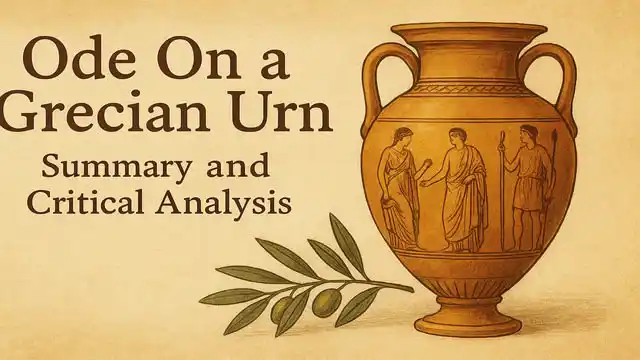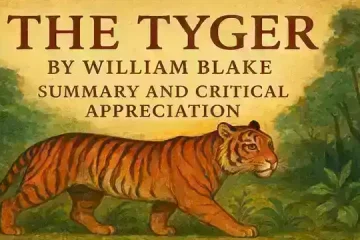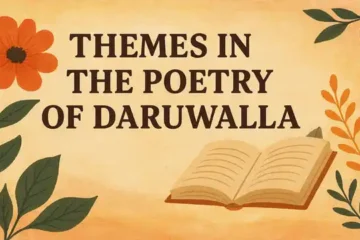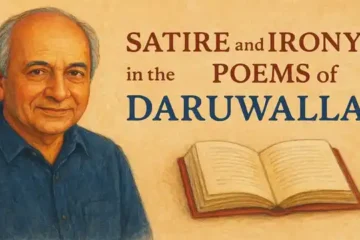Introduction of Poem:
“Ode On a Grecian Urn” is one of the finest odes of Keats. Keats wrote it in the same circumstances in which he wrote another great Ode to a Nightingale. A marble urn belonging to Lord Holland is the main source of this poem. The urn is still there in the garden at Holland house, Keniston. Various pictures representing ancient Greek art and culture are carved on this urn. Chief among them are the pictures of beautiful maiden who are being chased by their lovers and they (the maidens) are trying to escape them. A musician is shown playing pipe. This leads the young poet to the world of imagination and he concludes that these unheard melodies must be sweeter than heard melodies.
There are beautiful pictures of trees which will remain green and fresh forever. Beneath these trees a bold lover is trying to kiss his beloved Keats is again transported into the world of imagination and says that though the lover has not won her goal, his love for his beloved will always remain as intense as it is now and the beloved will also remain young and beautiful forever. There is an altar; a priest stands close by it. A bull is brought to be sacrificed at the altar. Another source of inspiration that went into the making of this poem is the beauty and grandeur of Greek sculpture revealed to Keats by the famous Elgin marbles.
Summary of the Poem “Ode On a Grecian Urn”:
The Address to the Grecian Urn
Keats addresses the Grecian urn as an “unravished bride of quietness and a faster – child of silence and slow time.” Thus Keats conveys to us the idea of the silent repose and the great age of this piece of Greek sculpture. He also calls the Grecian urn a “Sylvan historian” because of the rural and forest scenes carved on its surface.
In a series questions, which are also vivid pictures, he gives us an us an idea of what those carvings represent. He refers to the human beings and the gods depicted on the urn in the beautiful valleys of Tempe and Arcadia. He refers to the men in a passionate mood chasing maidens who are struggling to escape from their clutches. Then there are the flutes – players playing wild and ecstatic music.
The Idea of Unheard Melodies:
The poet goes on to say that music which is imagined is much sweeter than music which is actually heard. The music of the flute – players depicted on the Grecian urn cannot be actually heard by us: we must imagine what tunes they are playing.
Eternal Beauty and Love on the Urn:
These unheard, but imaginable melodies are sweeter than the songs that we actually hear. Besides, the lover who is trying to kiss his beloved on the urn will always be seen in the same mood of pleasurable anticipation. In real life, love and beauty decline and fade; but the love and beauty depicted on the urn will remain ever fresh.
Art’s Superiority Over Life:
In real life, spring is short, and the trees must shed their leaves. Similarly, in real life a musician will at least feel tired of playing his music and will stop. The enjoyment of the pleasures of love in real life is followed by disgust and satiety. But the trees depicted on the urn will never shed their leaves; the melodist will forever play his tunes, and the heart of the lover will always throb with passion while the beauty of the beloved will never fade. In this way, the poet wishes to convey the idea that art is, in one sense, superior to real life.
The Procession to the Sacrifice:
Then follows a picture of a crowd of people going to some place of worship. A priest leads a heifer which has been decorated with garlands and which is to be offered as a sacrifice. The worshippers have come from some little town situated close to a river or on a sea – shore or at the foot of a hill on which stands a fortress. The town which has been emptied of its people will always remain desolate, because the people shown on the urn will always be seen going away to the place of worship but never returning to the town.
The Eternal Message of the Urn:
The poet then addresses the urn as “Attic shape”, “Fair attitude”, and “Cold pastoral”. These expressions convey the beauty and the poise of the urn and refer also to the rural scenes depicted on it. The feelings which the urn awakens in the poet are like the overwhelming feeling which arises when the poet thinks of eternity. The urn, says Keats, will always be a friend to man.
The Final Message: Beauty and Truth are One:
The generations of men will come and pass and will perhaps undergo sufferings and sorrows of which we have no notion at present. But the urn will have a valuable message for those generations, the message, namely, that, Beauty and Truth are not separate things but two sides of one and the same thing. (Or, Beauty and Truth are not two things, not even twin things, but one and the same thing seen from different aspects). The knowledge of this great fact is of supreme importance and this fact represents the very essence of wisdom. Having this knowledge, mankind needs no other knowledge.
Critical Analysis of the Poem:
Introduction:
The poem entitled “Ode on A Grecian Urn” was composed in May 1819. Urn is a vase – like pitcher in which the Greeks kept the ashes of the dead. The urn had carvings and artistic patterns which made them work of art, hence a piece of display also. It is known that Keats was interested in Greek art, literature and sculpture. He might have seen many urns, or pieces of urns in British Museum or in the illustrated works of art and literature. Keats did not have any particular Urn in his mind when he wrote this poem.
It is Keats’ creative faculty, the power of imagination, which shaped many a scene and floral pattern into one organic whole. The Urn of Keats is an urn of his own rich creative imagination. The poem is a perfect illustration of Keats’ dictum that “A thing of beauty is a joy forever.”
Keats made his urn a thing of beauty and it is a joy forever. He blended several threads from his readings and experiences— his love of Greek art , the nearness of pain and pleasure, the stormy nature of passions and the severity of the ideal along with the equation of Beauty and Truth.
Vivid and Concrete Pictures:
A striking quality of Keats’ entire poetry is fully revealed in this ode. Keats had a genius for drawing vivid and concrete pictures mostly with a sensuous appeal. The whole of this poem is a series of such pictures—passionate men and gods chasing reluctant maidens, the flute – players playing their ecstatic music, the fair youth trying to kiss his beloved, the happy branches of the trees, the worshippers going to a place of worship in order to offer a sacrifice with a mysterious priest to lead them, a little town which will always remain desolate—these are pictures which Keats vividly brings before our minds.
The passion of men and gods, and the reluctance of maidens to be caught or seized is beautifully depicted in the following two lines:
“What men or gods are these? What maidens loth?
What mad pursuit? What struggle to escape?”
Here is the picture of a bold lover trying to get a kiss which will never materialise:
“Bold Lover, never, never canst thou kiss,
Though winning near the goal –”
The ecstasy of the passion of youthful love is depicted in the following lines:
“More happy love! More happy, happy love!
For ever warm and still to be enjoy’d
For ever panting and for ever young.”
An important idea in this ode is that, art is superior to real life in certain respects. The trees depicted on the urn will always enjoy spring. The flute players shown on the urn will never tire of playing tunes which are ever new. The passion of the lovers depicted on the urn will never decline, and the beauty of the beloved will never fade. Heard melodies are sweet but those unheard are sweeter. The music of the flute – players depicted on the urn has a sweetness which music in real life can never possess.
Unity of Truth and Beauty:
The central thought of this ode is the unity of Truth and Beauty. Beauty and Truth, says Keats, are not two separate things. They are one and the same thing seen from two different aspects. What is beautiful must be true, and what is true must be beautiful. There can be no question of Beauty being separated from Truth. Every piece of art which is based on truth or reality must be beautiful; and every beautiful work of art must have a hard core of truth in it.
Thus Keats seems to reject the school of gross realism in art on one side, and the school of ornament for ornament’s sake on the other . Keats may have no right to frame a law for the artist, but the idea contained in the final stanza of the poem may justly be regarded as his main contribution to speculative thought.
Poetic Power:
This ode represents the maturity and the height of Keats’ poetic power. His poetry is essentially imaginative and emotional, but his greatest poems possess also an intellectual appeal. This ode, for instance, represents an exquisite fusion of the imaginative, emotional, and intellectual elements.
The moral of the urn, namely, that Beauty is Truth and Truth is Beauty, has an intellectual basis. But, apart from this, the poem is charged with emotion and shows rich imagination. The first three stanzas, especially, have a passionate quality about them. Lines already quoted above in a different context amply show that.
Form and Structure:
This ode is written in a regular stanza of ten lines, consisting of a quatrain and a sestet. Thus it does not follow the pattern of the long unequal stanzas of the Ode to Psyche. Like most of his other poems, this ode shows Keats’ genius for coining original, striking, and appropriate phrases. “Sylvan historian”, “leaf – fringed legend”, “a heart high – sorrowful and cloy’d”, “Cold pastoral”, and “Fair attitude” are some of the examples; while the statement “Beauty is Truth, Truth is Beauty”, is a neat and compact expression of a profound fact, an expression which is one of the most often quoted from English poetry.




